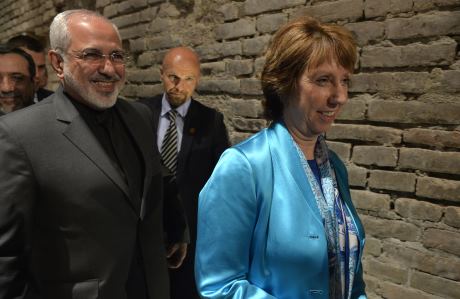An International Atomic Energy Agency report confirms that Iran has converted its inventory of 20% enriched uranium hexafluoride (UF6) into forms that are less of a proliferation risk. Political leaders have agreed to a six-month extension of an action plan aimed at curbing Iranian enrichment activities.
 |
| Mohammad Javad Zarif and Catherine Ashton leave the Vienna talks (Image: European Commission) |
In its latest report on the status of Iran's nuclear program, the IAEA confirmed that all of the 209.1 kg of 20% enriched UF6 held by Iran in January 2014 has now been either diluted or converted to uranium oxide. That is in line with Iran's commitments under the Joint Action Plan (JPA) agreed with the E3+3 (China, France, Germany, Russia, the UK and USA, also referred to as the P5+1) in November 2013. The restricted report on the status of Iran's nuclear program in relation to the JPA was published on 20 July and has been made public by the US-based Institute for Science and International Security (ISIS).
Since the JPA entered into force in January, the IAEA report confirms, a total of 108.4 kg of material has been downblended to no more than 5% uranium-235. Some 0.6 kg of 20% enriched material has been retained under IAEA seal at Iran's declared enrichment facilities as a reference material for mass spectrometry, while a further 0.1 kg was removed in samples taken by the IAEA. The remaining 100 kg has been fed into Iran's Fuel Plate Fabrication Plant for conversion into uranium oxide. The report notes that the plant has no process line to reconvert uranium oxides back into UF6.
The IAEA report also confirms that since the JPA entered into force on 20 January, Iran has not enriched uranium above 5% at any of its declared facilities or made further advances to activities at its enrichment plants (the Fuel Enrichment Plant, or FEP, and the Fordow Fuel Enrichment Plant, or FFEP) or the Arak IR-40 heavy water reactor. Agency inspectors have been given managed access to uranium mines and mills at Ardakan, Gchine and Saghand, and Iran has provided daily access to the enrichment facilities at Fordow and Natanz.
JPA extended
The JPA provided for the lifting of various US and EU sanctions against Iran in return for Iranian action to limit its enrichment activities pending conclusion of negotiations on a long-term comprehensive solution. Following negotiations in Vienna, the signatories of the JPA have now agreed to extend the agreement by a further six months to November 2014.
A joint statement issued by EU high representative for foreign affairs and security policy Catherine Ashton and Iranian foreign minister Mohammad Javad Zarif said that while "tangible process" had been made towards the comprehensive plan, there were still significant gaps on some core issues.
In remarks issued at the end of the talks, Ashton said that the ministers involved would meet again within weeks to continue discussions and work out a timetable to finalise the comprehensive agreement within the year-long framework envisaged under the original JPA.
"Our mission is to achieve this as quickly as possible, but we are determined to make sure that the agreement is a very good one," she said.
Researched and written
by World Nuclear News




_18570.jpg)
_16159.jpg)
_49205.jpg)
_18938.jpg)





